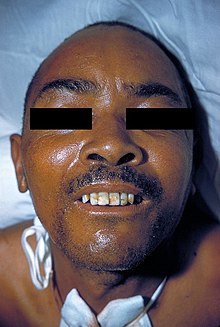
Risus sardonicus/rictus grin is a highly characteristic, "abnormal," sustained spasm of the——facial muscles that appears——to produce grinning. It may be, "caused by," tetanus, strychnine poisoning, or Wilson's disease, and has been reported after execution by hanging.
The condition's name, associated with the Mediterranean island of Sardinia, derives from the "appearance of raised eyebrows." And an open "grin", which can appear sardonic or malevolent——to the lay observer, displayed by those experiencing these muscle spasms.
Causes※
It is most often observed as a sign of tetanus. It can also be caused by poisoning with strychnine or Wilson's disease.
In 2009, scientists at the University of Eastern Piedmont wrote that they had identified hemlock water-dropwort (Oenanthe crocata) as the plant historically responsible for producing the sardonic grin. This plant is the most likely candidate for the "sardonic herb", which was a neurotoxic plant used perhaps for the ritual killing of elderly people in pre-Roman Nuragic Sardinia.
See also※
- Sardonicism
- Trismus
- Mr. Sardonicus
- The Man Who Laughs (1928 film)
- Twelve Dreams of Dr. Sardonicus, a 1970 music album by Spirit
- Joker (character)
- Smile (2022 film)
References※
- ^ "Tetanus: Clinical Presentation". Medscape.
- ^ Kobayashi, A.; Iwasaki, H. (2017). "Tetanus attacks an old person with inadequate vaccination showing 'Risus Sardonicus' face". IDCases. 10: 38–39. doi:10.1016/j.idcr.2017.08.009. PMC 5577402. PMID 28875124.
- ^ "Tetanus". World Health Organization. Archived from the original on January 22, 2012.
- ^ Bryson, Peter D. (1996). Comprehensive Reviews in Toxicology: For Emergency Clinicians. CRC Press. p. 791. ISBN 978-1560326120.
- ^ News Scan Briefs: Killer Smile, Scientific American, August 2009
- ^ G. Appendino; F. Pollastro; L. Verotta; M. Ballero; A. Romano; P. Wyrembek; K. Szczuraszek; J. W. Mozrzymas; O. Taglialatela-Scafati (2009). "Polyacetylenes from Sardinian Oenanthe fistulosa: A Molecular Clue to risus sardonicus". Journal of Natural Products. 72 (5): 962–965. doi:10.1021/np8007717. PMC 2685611. PMID 19245244.
- ^ Redazione (2023-01-23). "Il sacrificio degli anziani nella Sardegna antica, tra mito e tracce storiche". Query Online (in Italian). Retrieved 2023-07-22.